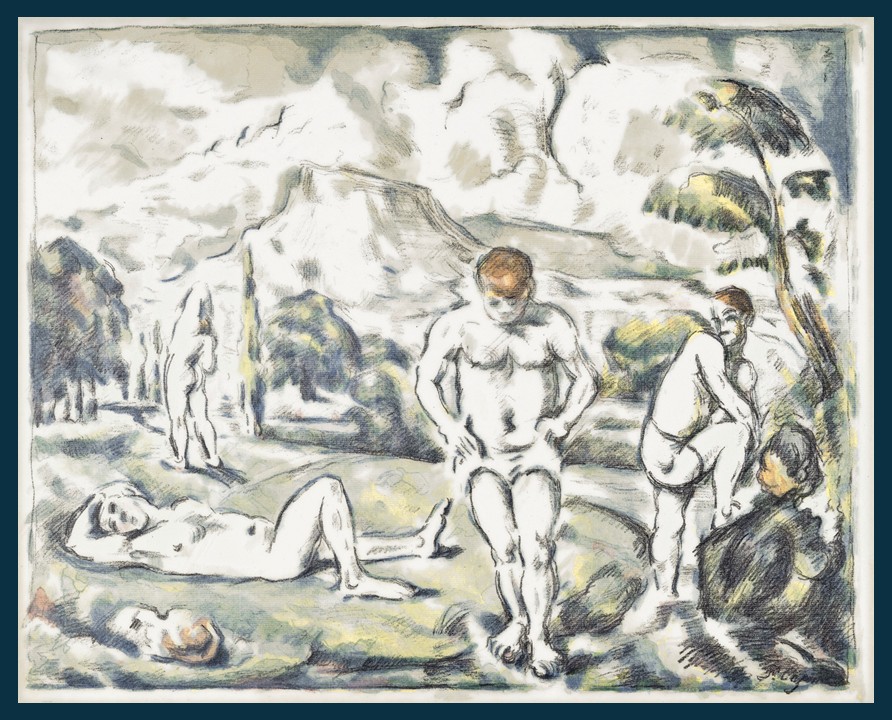
Les Baigneurs (Large Plate), 1896-1897, lithograph in colors, 419 x 521 mm, Private Collection https://www.christies.com/en/lot/lot-6528944
Paul Cézanne’s lithograph Les Baigneurs is a masterful meditation on the relationship between figure, form, and landscape. Unlike the more polished bathers of classical tradition, Cézanne’s nude figures appear elemental, emerging from and dissolving into the terrain around them. In this image, boundaries blur… bodies echo trees, limbs mirror rocks, and space folds in on itself with quiet intensity. The muted tones and broad color planes evoke both physical solidity and ephemeral motion, inviting a deeper contemplation of perception and structure. As one haiku inspired by the work reflects: Colors breathe in stone / lines dissolve, rebuild the world, / depth through fractured light. This interplay of solidity and ambiguity is where Cézanne’s genius resides, offering not just a scene, but a new way of seeing.
Paul Cézanne (1839–1906) was a French Post-Impressionist painter whose work laid the foundation for the transition from 19th-century Impressionism to 20th-century modernism. Born in Aix-en-Provence to a wealthy banking family, Cézanne initially studied law before turning fully to art, despite his father’s objections. He moved between Paris and Provence throughout his life, forming a friendship with Émile Zola in his youth and later connecting with key Impressionists like Camille Pissarro. Though his early work was dark and expressive, Cézanne gradually developed a more structured, analytical approach to painting. His work was largely misunderstood during his lifetime, but he gained recognition late in his career, ultimately influencing generations of modern artists including Picasso, Matisse, and Braque.
Cézanne’s style is marked by a deep concern for form, structure, and the underlying geometry of nature. Rather than capturing fleeting light as the Impressionists did, he sought to depict the enduring essence of what he saw. He used repetitive, deliberate brushstrokes and patches of modulated color, what would later be termed “constructive strokes”, to build volume and depth. Cézanne broke traditional perspective, often presenting multiple viewpoints within a single composition, which gave his work a dynamic tension and spatial ambiguity. His landscapes, still lifes, and figure paintings are all composed of an architectonic sensibility, where every object, no matter how ordinary, is given weight and presence. This analytical approach, especially his reduction of natural forms into geometric shapes, cylinders, spheres, and cones, was a major steppingstone toward Cubism and modern abstraction.
The artist’s forays into lithography were limited, but they reflect his lasting interest in reworking earlier motifs through printmaking. According to MoMA experts, he produced a lithograph of Les Baigneurs as part of a small edition. It was one of just three lithographs he ever contributed to commercial portfolios, including an early series proposed by Ambroise Vollard. The famous Les Baigneurs (Large Plate) lithograph was created in 1896–97 and printed in colours on Ingres d’Arches paper, before an edition of one hundred. This work reinterprets his earlier oil paintings. It emphasizes bold contours, solid forms, and a strong pictorial structure of male figures immersed in swirling vegetation. The lithograph heightens Cézanne’s sculptural approach to composition. The figures lack modeled volume, seem suspended in the landscape, and show a deliberate disregard for traditional perspective. This spatial tension mirrors Cézanne’s experimental treatment of form and depth throughout his work.
Les Baigneurs (Large Plate) stands as a rare and refined expression of Cézanne’s artistic vision, rendered through the unconventional and demanding medium of color lithography. Its carefully balanced composition, where figures, trees, and terrain cohere into a unified, sculptural rhythm, demonstrates Cézanne’s ability to impose structure without sacrificing the organic vitality of nature. The lithograph’s planar brushwork and spatial ambiguity echo the artist’s mature style, inviting viewers into a world that feels both timeless and constructed. Given that Cézanne created only a handful of lithographs in his lifetime, this work is not only a masterclass in formal innovation but also a rare glimpse into how he adapted his painterly concerns to print. It is a composition that distills his lifelong pursuit: to capture the permanence of form within the fleetingness of vision.
For a PowerPoint Presentation on Paul Cézanne’s paintings of ‘Bathers, please… check HERE!
Bibliography: https://www.christies.com/en/lot/lot-6528944 and https://www.moma.org/collection/works/59624 and https://www.artgallery.nsw.gov.au/collection/works/170.2006/#about